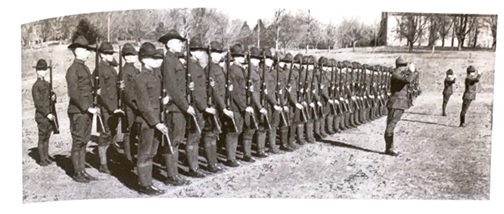Education
Despite the essential nature of the B Sections, the Committee on Education and Special Training (CEST) were very restrictive when it came to which groups of people were eligible for both sections of the SATC. In a descriptive circular about the SATC, published just two weeks after the start of the program, the CEST ordered that “registrants who have a grammar school education are eligible for Vocational Sections . . . Registrants who are graduates of four-year secondary schools or have equivalent qualifications are eligible for Collegiate Sections.”1 While dividing men based on education status was a quick, convenient method, it alienated men who might have been good officers but did not continue their education through high school.

The CEST solidified the divide between the A and B Sections even before the program began. A memo from the CEST to all professors tasked with teaching War Issues course, which was a requirement for both A and B Sections, highlights separation of the two groups: “While the same instructors may perfectly well give courses to both the vocational and collegiate sections of the S.A.T.C., it will not be possible to give the same course to the two sections because of the widely varying conditions of time and the difference in the character and preparation of the two groups.”3 Though they would later claim that it was possible for movement between the two groups, it is clear that the CEST felt that men from the B Section could not keep up with the men from the A Section.
Lack of Upward Mobility
The CEST made a clear division between the A and B Sections of the SATC and used the vocational section almost as a punishment for men in the A Section. If anyone in the A Section fell behind, they were either transferred to a regular army camp as a private or “assigned to a Vocational Training Section for technical training of military value.”4 For someone hoping to be an officer, this was a severe punishment.

While a clear path was outlined for moving men from an A Section to a B Section, less clear was the way for men from a B Section to move to an A Section. The SATC Descriptive Circular states that men in vocational units, “may be recommended for officers’ or non-commissioned officers’ schools or may be continued at institutions for more advanced study.”5 This path of movement set up men for failure. If a solder was recommended for an central officers’ training school from a B Section, he would not have the same training as someone from an A Section. While the B Section soldier was learning a technical skills and going through basic military drill, his A Section counterpart was learning military theory and taking classes that would help him as an officer, like Map-Reading and French.
Post War
After the war, a report about the activities of the CEST during the war that was published in 1919 claimed that:
In order to open the privileges of the S.A.T.C. to all young men irrespective of their academic status . . . Any man with a grammar school education might then be voluntarily inducted into the corps. If he had not had high school training he was thus given an opportunity to demonstrate his ability to undertake the officer training and was transferred to the collegiate section as soon as his fitness was demonstrated. Conversely, students who had been admitted to the collegiate section but who were found unable to carry the work there might be transferred to the vocational section if their abilities indicated that this was desirable.6
Despite this claim there is little evidence to support that any mobility between the two sections ever took place, at least in Virginia SATC programs.
Notes:
- Student Army Training Corps Descriptive Circular dated October 14, 1918, 6, Box 3, Folder 8, Records of the Dean of the College, Theodorick Pryor Campbell, RG 11/1, Special Collections and University Archives, Virginia Tech, Blacksburg, VA.
- Harry Downing Temple, The Bugle’s Echo: A Chronology of Cadet Life at the Military College at Blacksburg, Virginia, The Virginia Polytechnic Institute, vol. III (1912-1920) (Blacksburg, VA: The Virginia Tech Corps of Cadets, Inc., 1998), 2143.
- The Advisory Board, Committee on Education and Special Training. A Review of Its Works during 1918 (Washington, 1919), 132, https://catalog.hathitrust.org/Record/000488027.
- Student Army Training Corps Descriptive Circular dated October 14, 1918, 5, Box 3, Folder 8, Records of the Dean of the College, Theodorick Pryor Campbell, RG 11/1, Special Collections and University Archives, Virginia Tech, Blacksburg, VA.
- Student Army Training Corps Descriptive Circular dated October 14, 1918, 5, Box 3, Folder 8, Records of the Dean of the College, Theodorick Pryor Campbell, RG 11/1, Special Collections and University Archives, Virginia Tech, Blacksburg, VA.
- The Advisory Board, Committee on Education and Special Training. A Review of Its Works during 1918, 26,https://catalog.hathitrust.org/Record/000488027.